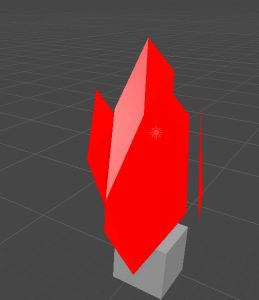Compute Shaders
This week i wanted to figure out a way to patch those cracks on the mesh. But after a lot of thinking and talking about it with different people, I noticed that the cracks are only a visual problem, but it will never effect the player in any way, if there isn't a real mesh or collider. And also, when the resolution is high enough, the cracks might be so small, that they aren't even visible anymore. So i decided to implement the marching cubes in Compute Shaders, to speed up the process of generating the mesh for each chunk significly. This took a lot of trial and error since i've never used compute shaders before. But after a lot of weird artefacts and a few gpu-crashes it finally worked.
I had to rewrite a lot of the marching cubes algorithm to run on he GPU and in parallel. Especially the parallel running and calculation of the triangles of the mesh led to a few funny-looking results.
 This should be a normal sphere.
This should be a normal sphere.
But now it's all up and running as it should.
Performance gains
When I made the switch to the compute shaders, I wanted to test how much faster the algorithm could now run. It probably could be optimised even more, but since I don't yet have to knowledge to do so, I will just leave it at that for now.
When comparing the times it takes on the single threaded CUP in C# vs multi-threaded GPU in compute shaders, I got those improvements: 125'000 verts 90 times faster 1'000'000 verts 160 times faster
Bottleneck
The only bottleneck I still have is the creation and calculation of the vertex position and wheter it's on the mesh or not. This is still happening in C#. So the task for next week will be to overhaul the entire system on how the vertices are created. I will probably make this also run on the GPU. Here I'm thinking about creating textures that then can just be sampled, but I will have to see what I can come up with.
Get TerraNovaOdyssey - Planet Generation
TerraNovaOdyssey - Planet Generation
Exploring and testing procedural generation of planets using marching cubes.
| Status | Prototype |
| Category | Tool |
| Author | Symetry |
| Tags | 3D, development, Indie, marching-cube, noise, planet, Procedural Generation, tool, Unity, urp |
More posts
- UI and materialsJun 04, 2023
- Player-InputJun 04, 2023
- Performance and Player-InputJun 04, 2023
- Crack-PatchingJun 04, 2023
- Implementing Marching CubesMar 19, 2023
- PlanningMar 05, 2023
Leave a comment
Log in with itch.io to leave a comment.